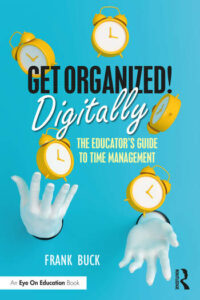The Educator’s Guide to Time Management
Get Organized Digitally! The Educator’s Guide to Time Management
By Frank Buck
(Routledge/Eye On Education, 2022 – Learn more)
Reviewed by Stephanie Choate

Well, this queen’s crown was rescinded as I was truly humbled at the sheer amount of organizational tools I do not know about – and found in Frank Buck’s book.
I generally help students in grades 6-12 with organization, study skills, and time management. Get Organized Digitally! is geared towards educators and educational leaders and offers the tips and tricks that can help make our day easier and help us get our work done efficiently. I do think some ideas could be offered to older students (though I would introduce the tools slowly).

The main lesson in the book is that anyone can write a to-do list, or have a sticky note system on their desk, but ultimately you need everything in one place. With technology at our fingertips, this has never been easier.
Buck shares that “school is what we do, not where we are,” and that was made abundantly clear throughout the pandemic. Many of us were abruptly separated from our color coded folders and desk calendars. Some of us learned the hard way that we need the tools we can access wherever we are, and we are lucky to have the technology to make that a reality.
The Tools
Buck offers detailed directions on how to find and use a handful of different tools, all of which are free but do offer paid subscriptions with extra features. The best part about the book is that Buck uses these sites and apps himself, so at every turn he is able to say “I name my folders X, Y and Z” or “I suggest checking off this box because…”. He has done a lot of the legwork for you, so you know how to get the best out of any platform he recommends.
From Remember the Milk task lists to Evernote, Google Calendars, and more, there is something for everyone (even time management queens) to learn. While I was very familiar with Google Drive and documents, Evernote was completely new to me, and I was able to use the directions in the book to explore how I could have a better collection of digital notes.
As a new department chair, I was excited to see examples of how to use Evernote to conduct classroom observations, and it is definitely something I am going to add to my toolbox. Even Buck’s “simpler” tips – like how to wade through a pile of emails – make me feel like my life will be easier in so many ways this school year.
Each chapter offers a different resource, and then the last chapter not only summarizes key points but also offers a dozen other quick tips and ways to integrate many of the tools so they can work together. I appreciated that Buck gave the resources that required more time and effort to learn the space they needed. To wrap things up, he devotes the last chapter to many different types of smaller management tricks.
The Stories
When the introduction said there would be stories about educators and educational leaders using the tools and apps, I was a little nervous. There is nothing worse than wanting a recipe for Chicken Parmesan, but you have to read the writer’s whole life story before you get to the list of ingredients. However, Buck embedded the stories in just the right places to show why and how a particular tool could be helpful.
The stories are relatable. We all know what it feels like to be pulled in multiple directions throughout the day: unread emails, parent phone calls, student work to read. I think that hearing about the success stories of other people helps motivate readers to put in the effort to try these strategies. There are even stories that show the value these tools can bring to your personal life.
The Takeaway
The true test of any organizational strategy is its sticking power. Organization, digital or not, is not a one-size-fits-all phenomenon. We could all list a system that works for us but may not work for your colleague, your student who never hands in their homework, or even your spouse. But the first step to taking control of your time is trying, and this book provides a ladder with all the rungs you need to get you there.
Stephanie Choate is the English Department Chair and a teacher at Austin Preparatory School in Massachusetts. A lover of Shakespeare, rhetoric, and young adult literature, Stephanie facilitates workshops with the PD Collab, has presented at a Keeping the Wonder workshop, and is also a trained executive function tutor. You can find her work and book recommendations on her Instagram @scarvesandseminars.



































Many thanks to Stephanie for this review. She touched on every one of the points about the book that I hoped would resonate with readers.